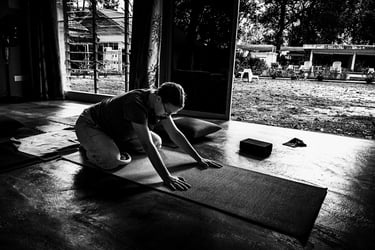Can Yoga Improve Memory?
When we think of memory, we often picture recalling facts or events - like the name of a pose or the day we first stepped onto a yoga mat. Yet memory is far more dynamic. It includes declarative memory (facts and events), procedural memory (skills and habits), emotional memory (responses tied to emotions), and working memory (temporary information we use to stay present and complete tasks).
Yoga, much like learning to ride a bicycle, engages memory in ways that extend beyond simple recollection. Different types of memory come into play during yoga practice.
Remember when you first learned to ride a bicycle? Balancing, steering, and pedalling felt overwhelming at first. But with repetition, those movements became second nature, stored in procedural memory. Yoga is no different.
The physical execution of asanas and sequences relies on procedural memory. Over time, consistent practice rewires the body and brain, making them instinctive. This allows practitioners to move effortlessly, freeing the mind from overthinking and enabling deeper focus on the experience.
Our bodies remember emotions as vividly as our minds. Yoga taps into this emotional memory, reinforcing positive responses and guiding beginners through the challenges of (cycling or) asanas.
For many practitioners, the feelings of calm, fulfilment, or relief after a session leaves an emotional imprint. These sensations make us want to return to the mat. On the flip side, challenging poses can evoke emotions like frustration or confusion - Why am I tighter on one side? - but these responses are part of the learning process. By engaging with these emotions, yoga offers opportunities for growth, acceptance, and adaptation, both physically and mentally.


Working memory keeps us present and responsive - much like a cyclist who constantly adjusts to road conditions. In yoga, it allows practitioners to remain attuned to alignment cues, navigate sequences, and respond to what our bodies are communicating.
For example, you might notice tension in your shoulders during a pose or feel your breath quicken as you hold another. By engaging working memory, you can make subtle adjustments - relaxing the shoulders, lengthening the spine, or softening your breath. This moment-to-moment awareness strengthens interoception (sensing internal signals) and proprioception (understanding body positioning), enhancing the connection between mind and body.
Declarative memory plays a minor role in yoga practice. It’s like remembering a bicycle brand - helpful, perhaps, but not essential when you’re on the road. Memorising the names for poses has value (for teachers) but it’s secondary to the physical and emotional experience of yoga. The true essence of practice lies not in rote memorisation but in embodying the poses, feeling sensations, and staying present.
Yoga and Learning
Yoga does far more than improve recall - it enhances the ability to learn. Practices like pranayama (breath control) and meditation activate regions of the brain, such as the prefrontal cortex, that are linked to attention, cognitive flexibility, and working memory. These functions are critical for learning, problem-solving, and adapting to new challenges.
While many equate memory with remembering facts, yoga reminds us that learning involves integration, focus, and presence. By improving our ability to pay attention and respond to what’s happening in the moment, yoga trains the brain and body to work in harmony - both on and off the mat.
Conclusion
Yoga engages the full spectrum of memory - procedural, emotional, working, and declarative - but its impact extends beyond mere recollection. It sharpens focus, builds resilience, and enhances the capacity to learn and adapt. In a world that often equates rote memorisation with intelligence, yoga offers a different perspective: growth lies in staying present, responding mindfully, and integrating body, mind, and breath.
